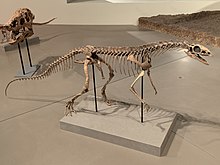Our website is made possible by displaying online advertisements to our visitors.
Please consider supporting us by disabling your ad blocker.
Asilisaurus
| Asilisaurus Temporal range: ?Anisian
? | |
|---|---|

| |
| Skeletal cast PR 3062 on display at the Field Museum of Natural History, Chicago, Illinois, USA. | |
| Scientific classification | |
| Domain: | Eukaryota |
| Kingdom: | Animalia |
| Phylum: | Chordata |
| Clade: | Dinosauria (?) |
| Clade: | †Ornithischia (?) |
| Family: | †Silesauridae |
| Genus: | †Asilisaurus Nesbitt et al., 2010 |
| Species: | †A. kongwe
|
| Binomial name | |
| †Asilisaurus kongwe Nesbitt et al., 2010
| |
Asilisaurus (/ɑːˌsiːliːˈsɔːrəs/ ah-SEE-lee-SOR-əs); from Swahili, asili ("ancestor" or "foundation"), and Greek, σαυρος (sauros, "lizard") is an extinct genus of silesaurid archosaur. The type species is Asilisaurus kongwe. Asilisaurus fossils were uncovered in the Manda Beds of Tanzania, a formation typically dated to the Anisian; however, some authors controversially assert that the formation may be early Carnian instead.[1] If it truly is Anisian, Asilisaurus would be one of the oldest known members of the Avemetatarsalia (animals on the dinosaur/pterosaur side of the archosaurian family tree). It was the first non-dinosaurian dinosauriform recovered from Africa. The discovery of Asilisaurus has provided evidence for a rapid diversification of avemetatarsalians during the Middle Triassic, with the diversification of archosaurs during this time previously only documented in pseudosuchians (crocodylian-line archosaurs).[2][3]
Asilisaurus is known from a relatively large amount of fossils compared to most non-dinosaur dinosauromorphs. This has allowed it to provide important information for the evolution of other silesaurids and the origin of dinosaurs. It had several unique features compared to its close relatives, such as a lack of teeth at the front of the premaxilla and a lower jaw which was not only toothless at the tip, but also downturned. These indicate that it probably had a small beak on the tip of the snout. It was fairly basal among silesaurids, and retained some dinosaur-like features absent in advanced silesaurids, such as a supratemporal fossa and a quadrate which overlaps the squamosal. On the other hand, it also retains primitive features contrasting with dinosaurs, including two hip vertebrae, a closed hip socket, a crurotarsal ankle, and a non-vestigial fifth toe of the foot.[2][3]
- ^ Novas, Fernando E.; Agnolin, Federico L.; Ezcurra, Martín D.; Temp Müller, Rodrigo; Martinelli, Agustín G.; Langer, Max C. (October 2021). "Review of the fossil record of early dinosaurs from South America, and its phylogenetic implications". Journal of South American Earth Sciences. 110: 103341. doi:10.1016/j.jsames.2021.103341. ISSN 0895-9811.
- ^ a b Nesbitt, S.J.; Sidor, C.A.; Irmis, R.B.; Angielczyk, K.D.; Smith, R.M.H.; Tsuji, L.A. (2010). "Ecologically distinct dinosaurian sister group shows early diversification of Ornithodira". Nature. 464 (7285): 95–98. doi:10.1038/nature08718. PMID 20203608. S2CID 4344048.
- ^ a b Nesbitt, S.J.; Langer, M.C.; Ezcurra, M.D. (2019). "The Anatomy of Asilisaurus kongwe, a Dinosauriform from the Lifua Member of the Manda Beds (~Middle Triassic) of Africa". The Anatomical Record. 303 (4): 813–873. doi:10.1002/ar.24287. hdl:11336/135536. PMID 31797580.
Previous Page Next Page


